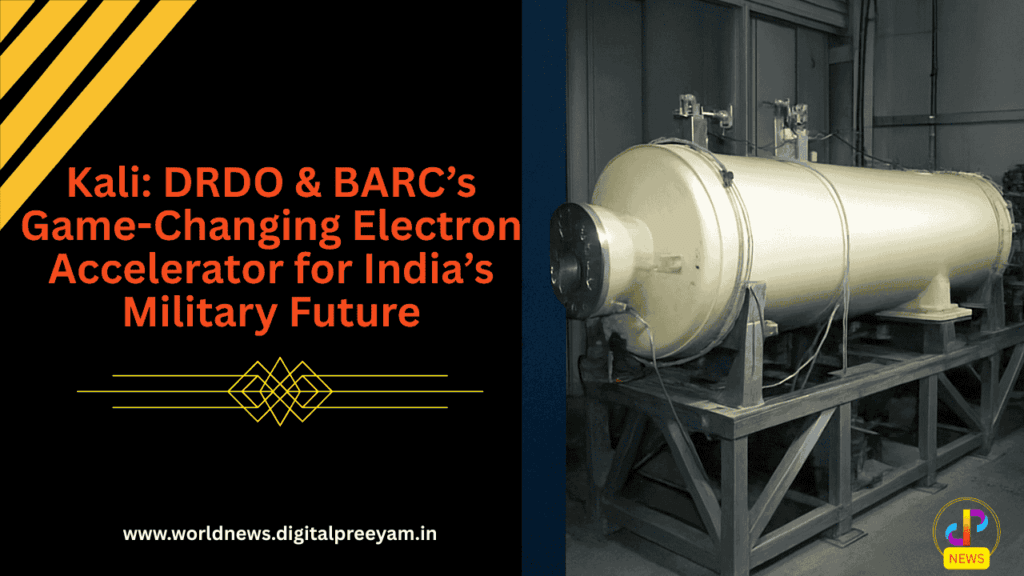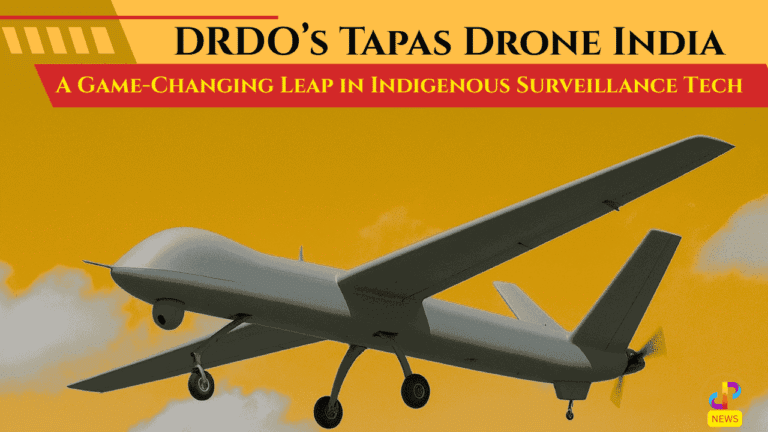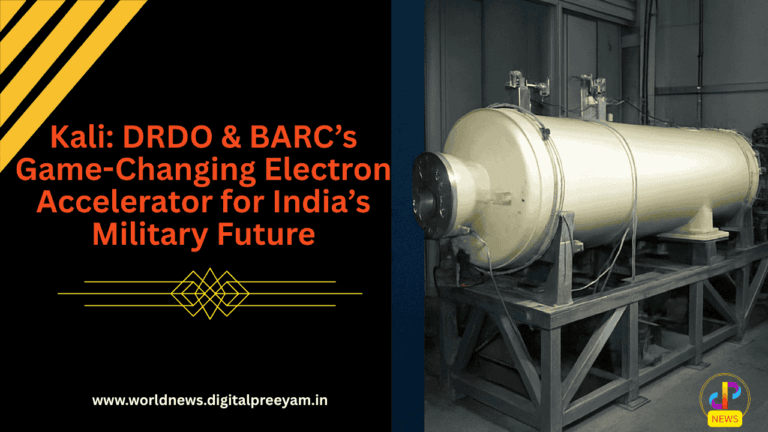Kali: India’s Secretive Electron Accelerator with Defence Potential
Kali – India’s High-Powered Electron Accelerator:
The Kali (Kilo Ampere Linear Injector) project is one of India’s most intriguing defence technology developments. Built jointly by the Defence Research and Development Organisation (DRDO) and the Bhabha Atomic Research Centre (BARC), Kali is a series of high-powered electron accelerators designed to produce intense, short-duration electron pulses.

These pulses can be converted into high-energy X-rays or microwave emissions, enabling applications ranging from ballistics research to directed-energy weapons. While still under development, the Kilo Ampere Linear Injector project represents India’s ambition to master advanced electronic warfare capabilities.
✨ Defence experts describe Kali as a potential “soft-kill” weapon that could one day disable enemy aircraft, missiles, or satellites by frying their onboard electronics.
Project Origins and Purpose of Kilo Ampere Linear Injector:
The Kali initiative traces its roots back to 1985, when visionary scientist Dr. R. Chidambaram, then Director of BARC, proposed the idea. The official project launch took place in 1989, with the goal of creating an electron accelerator for industrial and defence applications.
Key Highlights:
Collaboration: Jointly developed by DRDO and BARC.
Dual Purpose: From industrial X-ray research to defence-oriented electronic warfare.
Evolution: Multiple versions have been created, including Kali-80, Kali-200, Kali-1000, and the powerful Kali-5000.
Technological Capabilities of Kilo Ampere Linear Injector:
The Kali electron accelerator is capable of generating enormous bursts of electron energy in fractions of a second. Its unique design makes it adaptable for various scientific and military applications.
Electron Pulses: Produces powerful, high-current electron beams.
Electromagnetic Radiation: Converts electron energy into X-rays or high-power microwaves.
Directed Energy Potential: Offers possibilities for disabling enemy electronics without physical destruction.
Military and Scientific Applications of Kilo Ampere Linear Injector:
While shrouded in secrecy, several confirmed applications highlight Kilo Ampere Linear Injector’s growing significance:
Electronic Warfare: Potential to neutralize missiles, drones, or aircraft by targeting their electronic systems with microwave emissions.
Ballistics Research: X-ray bursts aid ultra-high-speed photography, essential for testing warheads and ammunition.
Electronic System Testing: Kali has been used to test and harden platforms like India’s Light Combat Aircraft (LCA) against electromagnetic attacks.
Satellite Protection: Research includes shielding satellites from electromagnetic pulses (EMPs), which could arise from nuclear blasts or enemy weapons.
Current Status and Challenges of Kilo Ampere Linear Injector:
Despite its promise, Kilo Ampere Linear Injector is not yet operational as a battlefield weapon. The system remains in advanced testing stages, with several hurdles to overcome:
Portability: Current versions are large, limiting their use in mobile combat situations.
Recharge Time: Presently designed for single-shot or limited bursts, making continuous use challenging.
Weaponization Efforts: Scientists are working on compact and deployable models for defence applications.
Experts suggest that miniaturization and rapid recharge will be key to turning Kali from a research project into a fully deployable weapon system.
Impact of Kilo Ampere Linear Injector on India’s Defence Future:
If weaponized successfully, Kilo Ampere Linear Injector could provide India with a game-changing advantage in electronic warfare, allowing the nation to neutralize threats without traditional explosives or missiles.
Strategic Edge: Disabling enemy systems remotely offers a strong deterrence capability.
Cost-Effective Defence: Using directed energy reduces reliance on expensive missile interceptors.
Technological Leadership: Positions India as a pioneer in emerging defence technologies.
Final Thoughts – Kilo Ampere Linear Injector and India’s Defence Innovation:
The Kali project represents the cutting edge of India’s defence research, balancing scientific discovery with military preparedness. Though still under development, its potential as a directed-energy weapon makes it one of India’s most ambitious defence initiatives.
🔥 As India continues to refine Kali, the world is watching closely—because its successful deployment could redefine the future of electronic warfare in Asia and beyond.
📢 Stay Connected with Digital Preeyam News – Your Guide to Defence Technology & India’s Strategic Future:
🌍 More than updates—Digital Preeyam News brings:
✅ Real-time coverage of India’s defence breakthroughs and global security trends
✅ Insights into cutting-edge military technology, electronic warfare, and innovations like Kali
✅ In-depth stories on DRDO, BARC, and India’s journey towards strategic self-reliance
📩 Subscribe now to stay updated on how projects like Kali are shaping the future of India’s defence and global power balance.
Writer:
Preeyam Kumar Prasad
(Digital Preeyam)
Social Media Profile:
❓ Frequently Asked Questions (FAQs):
1. What is Kali in defence technology?
Answer: Kali (Kilo Ampere Linear Injector) is a high-powered electron accelerator developed by DRDO and BARC that generates short, intense pulses of electron beams, which can be converted into X-rays or microwaves for defence and research applications.
2. Who developed the Kali project in India?
Answer: The Kali project was initiated by Dr. R. Chidambaram at BARC in 1985 and is jointly developed by the Defence Research and Development Organisation (DRDO) and the Bhabha Atomic Research Centre (BARC).
3. What is the purpose of Kali?
Answer: Kali was originally designed for industrial applications like ultra-fast X-ray photography but later adapted for defence purposes such as electronic warfare and testing the vulnerability of electronic systems.
4. Can Kali be used as a weapon?
Answer: Yes, Kali has the potential to act as a directed-energy weapon by emitting high-power microwaves that can disable enemy aircraft, missiles, and satellites by damaging their electronics. However, it is still under development.
5. What are the different versions of Kali?
Answer: Over the years, several models have been built, including Kali-80, Kali-200, Kali-1000, and the most advanced Kali-5000, each offering higher electron beam power.
6. What are the challenges facing the Kali system?
Answer: The major challenges include its lack of portability, slow recharge time, and the need to miniaturize the system for practical battlefield deployment.
7. How does Kali impact India’s defence capabilities?
Answer: If fully weaponized, Kali could give India a strategic edge in electronic warfare by neutralizing enemy systems without conventional explosives, making it a cost-effective and futuristic defence tool.







